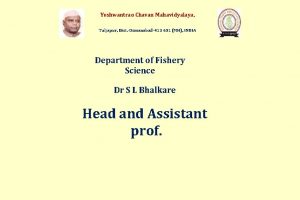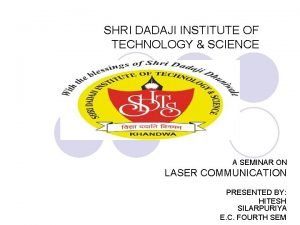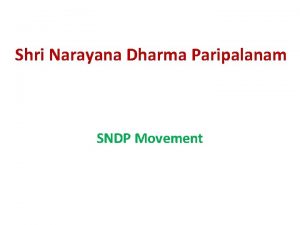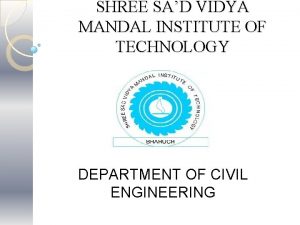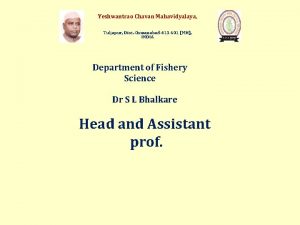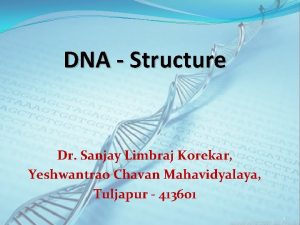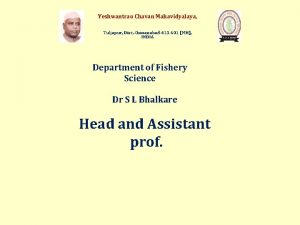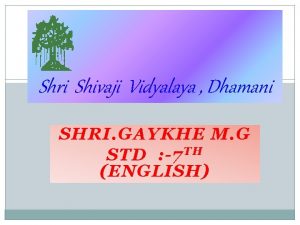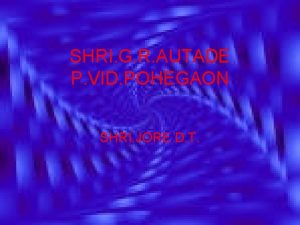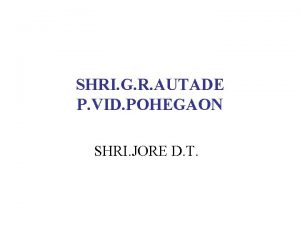Welcome Shri Surwase V P Yeshwantrao Chavan College





















- Slides: 21

Wel-come Shri. Surwase V. P Yeshwantrao Chavan College, Tuljapur

Class: B. Sc II yr, paper no. : Paper name: Ecology

Digestion in vertebrates � Buccal digestion � Mouth prepares the food for digestion � in higher animal the digestion of nutritive substance of food stuff begins in buccal cavity

salivary glands � In the buccal cavity of most vertebrate four pair of salivary gland are found � This are the infra orbital parotid sublingual and sub maxillary glad � In human there are only three pair their being no infra orbitals

Salivary gland of human

Parotid glands � These are the largest of the salivary gland found lying one on each side of face below the ears � These open into mouth opposite the site of the second upper molar teeth

Submaxillary glands � These gland Ares fond within lower jaws � These gland contest serous

Sublingual glands � These are embedded in the mucous membrane in floor of the buccal cavity

Saliva and its functions � Its mixed secretion of buccal gland the saliva viscous colour less cloudy liquid the p. H ranges 5. 6 -7. 6 � The saliva moistens the food and lubricating its passage � It content 98. 5 -99% water and 1 -1. 2% dense residue which include the following � Cellular component i. e. epithelial and leucocyte in organic component. It also consist inorganic and organic component

function � It moistens dry food and facilats by lubricating action � It provides an enzymes called salivary amylase � It digest starch � It keeps mouth and teeth clean

Movement of food from buccal cavity to pharyn. X � It is voluntary control , the tongue puss the food towards the teeth for breakdown

Movement of food from buccal cavity to pharynx

Movement of food from pharynx to oesophagous � Seens the pharynx is communicated with both oesophagous and trachea � The tongue move back like piston towards the posterior pharyngeal wall and forces to food bolus

Alimentery canal of human

4. Movement of food from oesophagous to stomach � It is a tubular structure that connects the bucopharyngeal region to the stomach � The food bolus carried down by the peristaltic movement of the oesophagous to the stomach

5. Gastric digestion � The gastric gland on the basis of there distribution in the stomach can be classified as below � Cardiac gland, cardiac glands, fundal glands, pyloric glands The gastric juice includes sodium chlorides potassium phosphates and enzymes pepsin, rennin, and gastric lypage It consist HCL

6. Enzymes & their action � Pepsin it is the proteolitic enzyme of gastric juice � Due to HCL it converts active pepsin having p. H 1. 6 -2. 4 � It digest pepton

7. Digestion in the small intestines � The small intestine content glands i. e. duodenal and intestinal gland � The intestinal juice consist erepsine lypage enteropepeptidase maltose, lactose, invertase, sucrose, nuclease etc.

8. Pancreatic juice – Nature & Action of Pancreatic enzymes � In man about 500 -800 ml secreted daily � It consist 98% of water and 2% of solid substance � It consist sodium bicarbonate , disodium phosphate , hydrogen phosphate � It consist enzyme trypsin, chymotrypsin, carboxy treptided pancreopeptided

9. Digestion in the large intestine � In mammal the medium of stomach is acidic due to HCL

Thank you
 Yashwantrao chavan college
Yashwantrao chavan college Heddy shri ahimsa putra
Heddy shri ahimsa putra Shri dadaji institute of technology and science
Shri dadaji institute of technology and science Shri bhairavdev vidyalaya
Shri bhairavdev vidyalaya Sndp movement pdf
Sndp movement pdf Shri ambika vidyalaya kedgaon
Shri ambika vidyalaya kedgaon Shri sad
Shri sad Welcome welcome this is our christmas story
Welcome welcome this is our christmas story Wake tech admissions
Wake tech admissions Early college high school at midland college
Early college high school at midland college Welcome to all participants
Welcome to all participants Welcome to ngss
Welcome to ngss Sample introduction of guest speaker for webinar
Sample introduction of guest speaker for webinar Welcome to the back of your mind
Welcome to the back of your mind Welcome amigo
Welcome amigo Welcome we're glad you're here
Welcome we're glad you're here Welcome to the english class
Welcome to the english class Welcome in indian languages
Welcome in indian languages Welcome to our english lesson
Welcome to our english lesson Welcome my dear students
Welcome my dear students Welcome to quarter 2
Welcome to quarter 2 Welcome to sunday service
Welcome to sunday service
